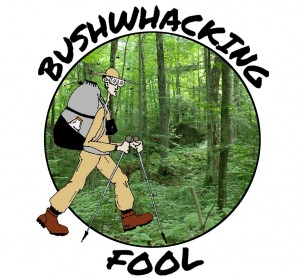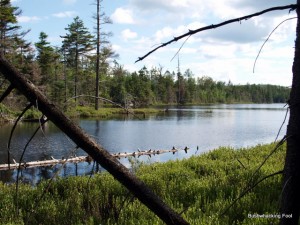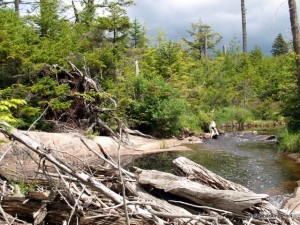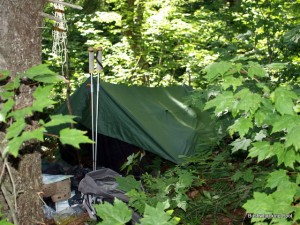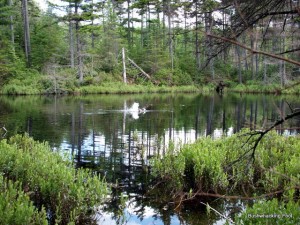The following is a description of an eight-day bushwhacking adventure into some of the most remote areas within the Five Ponds Wilderness in the northwestern Adirondacks. The trip includes traversing areas of intense blowdown along the oddly-shaped Oven Lake, exploring a cluster of wilderness ponds and following the wild Robinson River. The third part of day four includes a late lunch followed by a search for a campsite at northern tip of Oven Lake.
Section Stats:
Date: July 1, 2011
Length: 0.3 miles (1.7 miles for the day)
Difficulty: Moderate
Bushwhacking along Oven Lake’s shoreline followed by an arduous struggle through a tangled softwood blowdown has left me exhausted, sweaty and covered in dirt, duff and blood. Luckily, the portion of the lake’s outlet stream where I now find myself is rocky and fairly shallow so I can at least clean-up my face and hands.
I take a little time before venturing upstream to clean-up a little. Stooping down to the tannin-filled water, I cup some in my hand and pour it over my sweat-soaked head. Unsatisfied with the progress of this method, I fill my entire Gore-Tex hat with the cool water and return my hat to my head. The water pours over my head and down my back providing some temporary relief from the heat.
View Day Four Part Three in a larger map
Dark clouds are now scattered about, threatening an afternoon shower or thunderstorm. Occasionally, breaks in the clouds would develop and the penetrating sunlight illuminates patches of the ground and tree canopy. When the sun shines the temperature drastically increases and sweat pores off my skin, mixing with the blood and saturating my clothing.
I rock-hop upstream for a while until the rocks become less frequent and I am left with no choice but to force myself along the stream’s northern edge. There are many wet holes where once trees stood along the stream’s shore and it becomes increasingly difficult to avoid them. Luckily, my Asolo hiking boots and Integral Designs Shortie Gaiters prove once again to be an effective barrier to the wetness and my feet remain largely dry and comfortable.
The wetness and blowdowns force me off the edge of the stream and back into the regenerating softwood forest. The prospect of resuming my battle with the softwood tangle elicits an audible moan which thankfully no one is around to hear. Although I am exhausted from the day’s trek I have little choice but to force myself through the dense regeneration, occasionally climbing over a downed tree. It is my good fortune the forest along the stream’s northern shore is not as much of a tangled mess as what I endured to get to the outlet stream.
As I make my way back to Oven Lake, I notice something up ahead that simultaneously angers and amuses me. Back at the first peninsula I skipped while trying to get around the outlet pool is a very high beaver dam. It went totally unnoticed before because it is nearly level with the murky water and almost invisible from the other direction.
Damn! I could have skipped all that crawling through softwood blow downs and saved myself all those bruises and contusions.
When I finally stop laughing (and cursing) at myself, I bushwhack my way through the dense vegetation back in the vicinity of the shoreline of the lake (point #51). From the stumbling and swearing it is obvious that the last section has exhausted my energy reserves so I decide another break is way overdue.
By the time I approach the shoreline I am out of filtered water and still have not eaten lunch yet. I set up my gravity filter and hang it up in a nearby tree while I sit down for a very late lunch. It is nearly 3 pm and I have not had anything but a trail bar since breakfast! While eating my lunch I spend the time consulting my map and aerial photographs in search of a suitable campsite nearby.
Upon the conclusion of my late lunch, I start out in search of an adequate campsite along the northern tip of the lake. I start my quest along the edge of the northern of the two “fingers”. These two “fingers” are narrow, parallel channels forming the northern end of the lake. The northern one appears much longer from the aerial photographs as it is comprised of many interlocking beaver dams.
I do not hike for very long before finding an adequate place to set up camp. The site is just off a beaver path and therefore provides a convenient access point to the water in the channel. The dense vegetation makes this such a stealth campsite that when I am down at the water’s edge I have trouble seeing my tarp, even though I know exactly where it is.
The beaver trail leads down to a small sloped clearing at the water’s edge. Most of the channel’s shoreline is covered with low-lying shrubbery making it difficult to access the water without the presence of the clearing. A small channel of water leads from the clearing between the bordering shrubberies to the open water. Hopefully the beaver will not mind me using the clearing for a single night.
Since my lunch was late, I am in no hurry to start dinner. Instead, I filter more water and hang around the small clearing in search of wildlife and other photographical opportunities.
The bird community is very active here, with Swainson’s thrush, northern waterthrush, golden-crowned kinglet, song sparrow, red-eyed vireo and others singing consistently while I waited for the pangs of hunger to return.
While at the clearing the resident beaver comes over for a visit. The large rodent swims down the middle of the channel, keeping a significant distance between itself and me. Several times it splashes its trail in disapproval of my presence. After numerous splashes, the beaver moves on, either content in its duty of displaying disapproval or frustrated that its efforts did not result in my vacating the area.
Around seven PM I cook my dinner of salmon
and rice. My late lunch prevents me from eating the entire meal, so I use the beaver path to head into the forest in search of an ideal place to dispose of my leftovers. When I am an adequate distance from the lake, I dig a hole and bury the remainder of my meal. I plan on coming back tomorrow morning to check on whether anything disturbs it during the night.
I spend the remainder of the evening listening to the singing birds and the calling frogs. Nearby, a white-throated sparrow sings its typical “oh sweet Canada, Canada, Canada “ song. This is one of my favorite bird songs of the northwoods and I spend a great deal of time just enjoying it as I plan tomorrow’s hike to Cracker Pond.
As I retire for the night, I note the loud and constant calling of mink and green frogs. In addition, some seasonally-challenged spring peepers add their high-pitched peeps to the chorus. Soon the calls fade into the background as I slip off into a much-needed slumber after one of the most grueling days of bushwhacking ever.
Featured products:
Affiliate Disclaimer: Some links within this blog post may send you to a retailer website. If you chose to purchase any product at that site at that time the author will receive a small commission. These commissions provide compensation for the author’s time and effort necessary to provide the amazing content at the Bushwhacking Fool.
